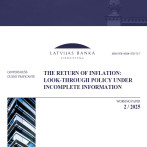The wage-productivity gap contracted most rapidly in the Baltic countries allowing the relevant industries to grow
The drop in per-hour labour costs in the second quarter was similar to the one in the first quarter, i.e. 9.6%. As before, labour costs have dropped a little more rapidly than wages: as the wave of layoffs died down, the amount of compensations shrunk; moreover, vacation pay, sick pay as well as the voluntary social security payments by employers also dropped faster than wages.
One of the main sources of the lack of balance in the Latvian economy - the previously accumulated gap between wages and productivity - has substantially contracted in the second quarter of 2010, with wages approaching the rates appropriate for the level of productivity. The competitiveness of the Latvian economy improved as a result, which influenced economic development: the lowest point of the recession has been overcome and economic activity is on the rise. As noted before, data of the Central Statistical Department (CSP) indicated that the seasonally adjusted quarterly changes in GDP in the second quarter of 2010 were positive for the second consecutive period.
The gap between wages and productivity opened in the second half of 2006 widening to the end of 2008[1]. It can be interpreted also as an excess of domestic demand over supply, which creates an upward pressure on inflation. Over the next year and a half the gap contracted substantially, both through dropping wages and, what is particularly important, through increasing productivity.
At the same time material differences are observed in the wage-productivity gap dynamics by industry. That causes big differences in the competitiveness of the industries as well as in their output and employment dynamics. To wit, in manufacturing the gap between wages and productivity contracted more rapidly, and it is therefore no surprise that this industry has become an engine of economic recovery: according to the CSP data, manufacturing in the second quarter of 2010 was the industry with the highest annual rise in value added (15%); the number of its employees has also grown over the year. In construction, on the other hand, the gap between wages and productivity is currently the widest and it is also the industry with the sharpest drop in output and employment.
Looking at the other Baltic countries, we see that in Estonia and Lithuania the gap between wages and productivity grew in 2006-2008, but then it began to shrink. By the second quarter of 2010 it contracted substantially in Lithuania, just like in Latvia, whereas in Estonia it is still large. That means that over the next few quarters productivity in Estonia should grow more rapidly than wages - otherwise employment growth will be delayed. Such a conclusion is supported by the dynamics of the number of hours worked (according to Eurostat national account data) - in the second quarter of 2010 the number of hours worked grew in Latvia and Lithuania constituting the first such growth in the past two years, whereas in Estonia it continued to drop.
[1] Wage-productivity gap is calculated as the diference between the index of seasonally adjusted wages and productivity, assuming that in 2000-2005, the work pay rate in the country corresponded to productivity.
Textual error
«… …»






